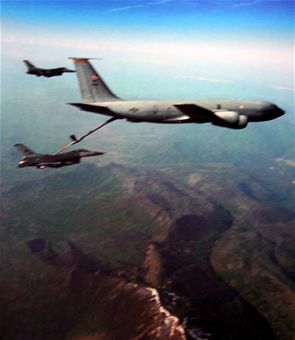
A KC-135R Stratotanker refuels two F-16 Fighting Falcons over northern Bosnia on a combat air patrol mission during Operation Allied Force in 1999.
NATO code name for peacemaking air campaign designed to protect ethnic Albanians in the Yugoslav province of Kosovo from Serb aggression and to force Yugoslav authorities to agree to a peace settlement. Operation ALLIED FORCE is often hailed as the first time in military history that airpower has achieved victory in a conflict on its own. Indeed, Operation ALLIED FORCE played a prominent role in ending ethnic cleansing in Kosovo, returning more than 840,000 refugees to their homes and restoring a semblance of peace to the troubled province.
Operation ALLIED FORCE rose from the ashes of the failed Rambouillet peace negotiations in January-February 1999, when a Serb delegation refused to accept a NATO peace plan for Kosovo. As negotiations collapsed on 19 March, Yugoslav President Slobodan Milosevic initiated Operation HORSESHOE, an operation designed to cleanse Kosovo of its ethnic Albanian population by force before NATO forces could be brought to bear. In the face of Yugoslav intransigence and escalating violence in Kosovo, NATO decided to proceed with Operation ALLIED FORCE on 24 March.
Initially, ALLIED FORCE was intended to be a short conflict with limited objectives. NATO would demonstrate its resolve to Milosevic, who would accept a negotiated settlement in the face of a limited NATO bombardment. ALLIED FORCE would then achieve its objectives of stopping the killing in Kosovo, returning refugees to their homes and creating the conditions for a political settlement. For the first nine days of the operation, NATO aircraft focused on so-called Phase I targets: the Yugoslav Integrated Air Defense System, command and control, and heavy weapons in Kosovo. NATO had 214 combat aircraft at its disposal as the conflict began, arrayed against a Yugoslav air defense system equipped with 16 MiG-29 Fulcrum fighters. Regardless, NATO aircraft achieved air superiority on the first night of the war. To avoid aircraft losses, Lieutenant General Michael Short restricted NATO fliers to a minimum altitude of 15,000 feet.
When Milosevic did not give in, NATO moved on to Phase II targets on 3 April and began targeting Yugoslav military forces south of the 44th Parallel. As the conflict continued to drag on and the refugee crisis worsened, ALLIED FORCE began to focus on the morale of the Serb public rather than Milosevic himself. On 1 May, NATO expanded its target set to include lines of communications, refineries, and electric power grids in Serbia. Despite a major setback following the accidental bombing of the Chinese Embassy on 7 May, NATO aircraft kept up a steady effort of about 250 combat sorties per day until Yugoslav military authorities agreed to NATO demands on 9 June.
Although historian John Keegan lauded ALLIED FORCE as proving a war can be won by airpower alone, Milosevic’s capitulation coincided with other key events of the conflict. In the last days of May, NATO leaders began publicly discussing options for a NATO ground offensive against Yugoslavia before the end of 1999. In addition, rebels of the Kosovo Liberation Army began a major offensive against Yugoslav forces in Kosovo on 26 May. Although the offensive failed, Yugoslav forces were forced to deploy to meet the rebel threat, which exposed their fielded forces to NATO air attack. Regardless, NATO airpower was the catalyst in ending ethnic cleansing in Kosovo in 1999.
References Carpenter, Ten Galen, ed. NATO’s Empty Victory, Washington, DC: CATO Institute, 2000. Daalder, Ivo H., Michael E. and O’Hanlon. Winning Ugly: NATO’s War to Save Kosovo. Washington, DC: Brookings Institute Press, 2000.